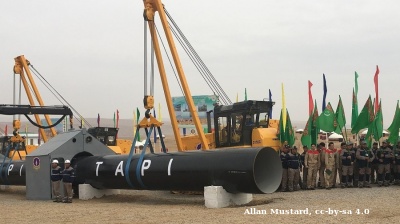There’s a continuously escalating hostility among Kazakhs towards China’s rapid expansion of its economic influence in Kazakhstan, but that’s no new topic I hear you say. Nevertheless, it’s a topic that won’t go away and, given some headline-grabbing disputes in recent months, now’s a good time to run a check on where things are at.
The issue took on a new environmental angle at the end of March when Kazakhs staged protests across cities and towns. Claims of China contaminating the environment focused on accusations that Kazakh authorities were allowing the Chinese to outsource some of their polluting industries onto the territory of Kazakhstan.
Kazakh news website Orda.kz quoted Zhabolat Mamai, the man responsible for organising the protest arranged for Almaty, as saying in a rally speech: “China began construction of 56 factories in Kazakhstan. By the end of 2023, the construction of all 56 will be completed. In return, they promise investments worth $24.5bn. Who will build these factories? Not our ordinary Kazakh [workers], but workers who arrive from China. At least hundreds and even thousands of Chinese workers will settle in Kazakhstan."
Mamai continued: “And then no one will be able to drive them out. This is the beginning of expansion. China never gives aid to anyone free of charge. Even in Africa the Chinese run their factories themselves. Do you know that our officials protect the interests of China and are ready to do anything for the sake of these investments? China gives billions. But as a result of this funding, Chinese influence is also set to arrive. They will have economic authority over Kazakhstan, and eventually political [authority].”
Mamai’s point was partly proven in the authorities’ nervousness ahead of the event. Despite granting a permit for the anti-China protest, law enforcement arrested at least 10 individuals in Almaty ahead of it without any explanation, local newspaper Nastoyasheye Vremya reported. The people, who were en route to the rally, were placed in police vans and taken away, the report said.
The actions directed from above, however, give off the air of a half-measure. Letting Kazakhs protest can be seen as a release valve for frustrations built up amid economic burdens emanating from anti-COVID-19 lockdowns that weigh on the backs of the poverty-stricken citizenry. The sanctioning of a rally is something like an administrative carrot, while the intimidatory tactics then applied to the event, such as pre-protest arrests, serve as the stick.
The government will not give up on finding ways to support its growing addiction to Chinese investment, a much needed factor in diversifying the economy away from dependence on oil exports. And, of course, China will not refrain from keeping a close eye on anti-Chinese sentiment in its ex-Soviet neighbour. Striving to keep China happy under such circumstances is a no-brainer.
The protests did in fact invoke a response from the Chinese Ministry of Commerce. The ministry’s spokesman, Gao Feng, on April 8 addressed the allegations that China has transferred polluting production enterprises to Kazakhstan. Gao said the claim went "against the facts" and had "ulterior motives”. He then cited figures on China’s investment in Kazakhstan, stating that it topped $7.83bn as of end-2020 and helped promote local employment and economic development. The spokesman also added that China-Europe freight trains made nearly 10,000 trips between China and Europe via Kazakh territory last year.
But as the contents of Mamai’s speech demonstrate, the protesters seriously doubt that the economic benefits of China’s investments in Kazakhstan will have a long-term advantage for the Central Asian nation.
Another aspect of the March 27 protests, as suggested by a Jamestown Foundation article published on March 30, could be that the protests were partly fuelled by the threat posed towards Kazakhstan’s Lake Balkhash by Chinese agricultural expansion in Xinjiang. The 16,400 square-kilometre body of water is Central Asia's largest lake and the subject of worry over its potential for becoming "the second Aral Sea" and thereby almost disappearing from the face of the Earth.

The Lake Balkhash drainage basin (Image: Kmusser, CC-SA-3.0).
Earlier in March, peer-reviewed journal Water published a study, titled “To save the lake, China would have to drastically reduce how much water it uses”. The study was widely publicised in Kazakhstan and across Kazakh media, partly thanks to a piece by Eurasianet.
China mainly at fault
The study, conducted using multiple simulations, concluded that the lake can only be saved if China dramatically cuts the amount of water it uses in Xinjiang; namely, stops drawing so much water from the Ili river that feeds Lake Balkhash.
The authors of the study pointed to the expansion of farming in China. Irrigated cropland around the Chinese side of the Ili grew by nearly 30% between 1995-2015. The threat this poses to Balkhash far outweighs any other potential danger. Kazakhstan, comparatively, did not see any significant rise in agriculture in the examined period, though there could be an acceleration in the future.
“Agricultural development remains a priority area in the current Five Year Plan of the Chinese government, and land use change studies indicate continued conversion of scrub and grassland into irrigated agricultural fields,” the study noted.
“Above all, the results underline the potential influence of changes in upstream water use on downstream water availability for different water users, intensifying existing trade-offs," it added, referring to, of course, the impact of China's water use on the availability of water in Kazakhstan.
The fate of the lake and the waters flowing into it is made even more ambiguous by gaps in data as a result of the challenging political situation in Xinjiang, agricultural modernisation throughout North-West China and rapid changes under the policy agenda of the Chinese infrastructure development Belt and Road Initiative (BRI), the study said. China’s hegemony, reinforced by the BRI, drives rapid changes in cultivation practices and water regimes, the study observed.
“The limited information available indicates that development plans for the next decades designate the Chinese Ili Prefecture as a key grain-production area, with less attention for rice. Perhaps this makes demand scenarios 2 and 4 (both 50% rice cropping) less probable and more moderately increasing demands (scenario AC3 with 15% rice cropping) more likely,” it said. But even with less water-intensive crops, the consensus of the researchers is that China would still overuse the waters.
The researchers mainly explored China’s responsibilities in the face of global climate change, but how could Kazakh authorities get China to abide by them?
Nothing new
The attempts to address China’s usage of the Ili river started more than a decade ago. Suggestions that Kazakhstan could simply negotiate its way to sufficiently limiting China’s draining of Lake Balkhash are nothing new. Recommendations by EU experts on the topic can be seen as far back as 2010.

A pier near Balkhash City (Image: Юрий Иванков, public domain).
An article by Kazakhstan Today quoted Russell Frost, an EU project lead on the “Introduction of Tools for Ecological Politics in Kazakhstan” initiative, as saying all those years ago that "it will be necessary to conduct serious negotiations with the People's Republic of China, because the springs and rivers that flow into the Balkhash, their upper reaches are on the territory of the PRC".
"Having analysed the agreement that is currently in force on water resources management between the Republic of Kazakhstan and the PRC, I can say that there are no specific mechanisms in this agreement that would restrict water intake in the upper reaches of those rivers that flow into Lake Balkhash and whose drainages are located on the territory of China."
"This agreement is unilateral, because it is practically only in the interests of China," Frost added, while suggesting that a new fully functioning document needs to be developed jointly by Kazakhstan and China that would restrict water intake from the upper reaches of the Ili river. He also stressed the necessity of forming Kazakhstan’s own national strategy for the conservation and management of Balkhash water resources in order to strengthen Kazakhstan’s negotiating position. That included advice on forming a single regulatory body on water issues.
"At the moment, water resources management in Kazakhstan is fragmented and suffers from conflicts of interest. International experience suggests that a single regulatory body is the right approach, integrating aspects of water use and wastewater disposal. In addition, such a body should not have an economic interest in water use," Frost concluded.
The recommendations are still as relevant today as they were back when Frost voiced them, and that serves to underline the lack of any real effort on Kazakhstan’s part to address the lake’s slow but quickening and inexorable road to demise. That does not paint a reassuring picture as regards Balkhash’s chances going forward.
In 2018, the then director of the transboundary rivers department at the Kazakh Ministry of Agriculture, Igor Kovalenko, told the local Kazinform news agency: “China, of course, is a dynamically developing country, the second biggest economy in the world. And it may soon become the biggest, and the understanding of environmental problems in China is also changing. One example is that for the first time in the existence of the Ministry of Ecology in China, it is now headed by an ecologist. A real ecologist who deals with environmental issues—this already says a lot. And the fact that China exists at the expense of natural resources will not end well. Currently, in many countries there is a [growing] understanding of the [importance] of preserving the ecological environment."

A farm worker ploughs a paddy field with a water buffalo in China. Too much water intensive agriculture could mean the end of Lake Balkhash (Image: Laurent Belanger, CC-SA-4.0).
Kovalenko also briefly mentioned the existence of ongoing negotiations between Kazakhstan and China, in which Kazakhstan was arguing for maintaining water flows into Balkhash at appropriate levels. The recommended levels would mean the lake’s water level dropping no lower than 134 metres. Anything below that would be catastrophic for the body of water.
Doomed by Kazakh plans alone?
The primary reason for China’s exploitation of Balkhash can be determined as the attempt by Beijing to attract Han Chinese settlers to Xinjiang as one way of suppressing the Muslim minorities: the ethnic-Uighurs, ethnic-Kazakhs and ethnic-Kyrgyz, among others, in the region. This doubles as part of the effort to boost China’s agricultural output.
But even in the event that China, in a highly unlikely outcome, completely abandons this strategy, Kazakhstan’s own plans to increase use of the Ili river remain a big anxiety.
Kazakhstan has committed to increasingly ramping up its agricultural production. It is eyeing the possibility of becoming a regional food hub. The catch is that Kazakhstan hopes to supply most of hub’s food to China—a kind of de facto outsourcing of food output generated for China that ties into Kazakhstan's aspirations for further integration into the BRI. China's growing middle class has created a demand for organic food that Kazakhstan aims to specialise in.
So even aside from China’s use of the waters upstream from Balkhash, the risk of a “second Aral Sea” scenario could stem from Kazakhstan’s plans alone.
The chances of effectively addressing these concerns at both ends of the Ili might, thus, border on the impossible.



